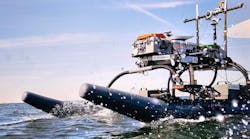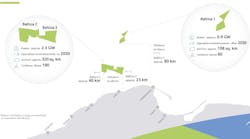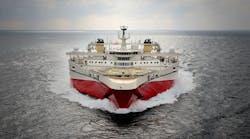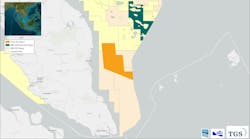The Industry Technology Facilitator (ITF) has launched two new development projects to help produce maps of hydrocarbon location and thus enable more accurate targeting of reserves. Researchers at Imperial College London and Offshore Hydrocarbon Mapping (OHM) have secured a total of £2.5 million ($4.9 million) of industry and government funding for projects, following a call for proposals from ITF last year.
This call for proposals resulted from a global discussion involving not only ITF and its members, but also the UK Government-Industry Initiative PILOT and Oil and Gas UK. Thirty exploration experts met to assess requirements, to identify major technology needs, and to establish prominent technological themes in exploration technology. Out of this process, came “Hydrocarbon Mapping through Integrated Geophysics,” which invited R&D proposals focused on use of advanced imaging technologies and their processing to improve the industry’s ability to locate hydrocarbons.
“One of the challenges identified during our discussion process was that we are striving for the ultimate goal of fully integrating seismic and non-seismic methods to produce a hydrocarbon map of the area of interest,” says ITF’s subsurface technology manager, Duncan Anderson. “It is recognized that much work is being undertaken in this area and that many valuable developments are being worked on around the world. The purpose of this call was to add to this body of work by challenging researchers to think beyond current limits and to propose projects which have the potential to significantly change the industry’s ability to ‘see’ hydrocarbon reserves.”
The ultimate capability of survey techniques comes from their integration, and the greatest gain is when seismic and electromagnetic (EM) technologies can be combined, leading to a greater understanding of subsurface properties and helping to de-risk the exploration process, Duncan says.
“Both the Imperial College and OHM projects tackle the integration of seismic and EM data, and the number of organizations that have pledged their support to the projects is a strong reflection of the potential benefits that they could bring to the entire industry,” says Duncan.
Seismic uses the characteristics of acoustic signals reflected from different subsurfaces to identify geological structures. It gives good spatial resolution and defines geological structure accurately, but struggles to provide information about pore fluids or permeability. A variation of seismic technology, known as “full wavefield visco-elastic tomography” can give more information about hydrocarbon content by accounting for the complete interaction of the seismic signal with the rock through which it is passes. Processing of the data produced becomes more time consuming and complex, however.
Controlled-source electromagnetic imaging (CSEM) may prove the most important new technology in the field of offshore oil and gas exploration since the advent of 3D seismic some 20 years ago. CSEM is an offshore geophysical technique using electromagnetic remote-sensing technology to detect the presence and extent of hydrocarbon accumulations below the seabed. The CSEM survey uses a dipole source towed just above the seafloor to transmit an electromagnetic field. This field is modified by the presence of subsurface resistive layers, and these changes are detected and logged by an array of receivers placed on the seabed. Because hydrocarbon-bearing formations are highly resistive compared with surrounding formations (in terms of what is contained within the rock pores, saline is conductive, whereas hydrocarbons are non-conductive), a CSEM survey can indicate the presence of hydrocarbons. CSEM imaging may reduce the risk of drilling dry wells, creating obvious value for oil and gas explorers.
Both CSEM and seismic techniques produce vast quantities of data, the analysis of which involves a complex computing process called inversion. In general terms, the data from different datasets is inverted separately and the results are brought together to identify areas where there is a likelihood of hydrocarbons. Both projects being delivered by Imperial College and OHM combine the different data outputs and inverting them jointly. This joint inversion is the key to mapping the location of hydrocarbon reserves with an accuracy not otherwise possible.
“The two projects that have been funded are complementary to one another and the results of them could transform current practices of how geophysical data is processed and interpreted,” says Duncan. “The work at Imperial College, lead by Professor Mike Warner, is pushing forward the boundaries of the underpinning science in this area by looking at the joint inversion of an advanced form of seismic data and CSEM.
“OHM has been at the forefront of applying CSEM technology since its spin out from Southampton University in 2002. Its project is to investigate the integration of seismic, CSEM, and well log data. Work is to include establishing an optimum algorithm for remapping CSEM results into the higher resolution seismic data and to develop a joint inversion methodology for seismic and CSEM data. It is hoped that there will be considerable scope for the results of their work in life of field monitoring as well as the investigation of remaining reserves in apparently depleted fields.”
The two projects are being supported by a total of 11 companies and the UK Government Department for Business, Enterprise and Regulatory Reform (BERR).
“The current climate of high oil prices highlights the importance of this kind of research and its potential contribution to the maintenance of hydrocarbon supplies,” says Malcolm Wicks, UK minister for energy. “I am particularly pleased to see that this is the sort of work that could help de-risk enhanced oil recovery and improved oil recovery projects by more closely targeting remaining oil, and therefore has particular benefits for a maturing province such as the North Sea.”
Projects Explained
Imperial College, London
Joint 3D inversion of full-wavefield P, S, and CSEM data.
P-wave seismic reflection data provides high spatial resolution of the subsurface, and delimits structure accurately, but struggles to identify pore fluids and provides minimal constraints upon permeability. In contrast, CSEM measures a property that relates strongly to hydrocarbon content and to the interconnectivity of pore space. However, the structural resolution of EM data is limited, especially in complex geometries. Full elastic seismic data also is sensitive to hydrocarbon content in the subsurface.
This project, led by Mike Warner at Imperial College, is concerned with the joint inversion and interpretation of 3D seismic and 3D CSEM data to combine the structural fidelity and depth control of P-wave reflection imaging with the direct hydrocarbon sensitivity of both CSEM and full elastic seismic data.
The project builds upon experience gained under a previous ITF project – FULLWAVE – in which Imperial College developed a method for 3D full-wavefield acoustic tomography which can produce highly resolved P-wave velocity models in 3D from realistically sized field datasets. The full-wavefield approach lies at the heart of the proposed joint seismic/EM inversion.
OHM Ltd.
Rock property analysis through the integration of seismic, EM, and well log data.
Improved reservoir management and production optimization demands require accurate characterization of reservoir properties and their changes through time. By integrating complementary sources of information and exploiting the strengths of each, estimates of rock and fluid properties such as gas saturation and porosity can be obtained with greater confidence than from any one data type alone.
This project is to investigate the integration of three contrasting and complimentary data types: seismic, CSEM, and well log data, and will examine how they can be used most effectively to determine reservoir and fluid properties. The objective of the project is to develop methods to predict rock and fluid properties from the integration of surface seismic, CSEM, and well log data. The aim is to provide maps of reservoir properties (such as porosity or hydrocarbon saturation) across the extent of a field. The approaches will help industry use the strengths of these diverse data types, and thus add value to both existing data and new acquisition. In due course, the outcomes of the project aim to help further reduce exploration risk and uncertainty in reservoir production, enabling oil producers to maximize production and increase recoverable reserves.
A not-for-profit global organization owned by 15 operating and six service companies, ITF fosters innovation and facilitates development and implementation of new technologies that will increase hydrocarbon recovery from mature basins and frontier exploration areas. This is achieved by adding value through a partnership with its members to understand their ongoing business driven technology needs.
ITF systematically identifies the shared technology needs of its member companies, seeks out innovative solutions, launches collaborative joint industry projects (JIPs) with up to 100% funding available for successful technology proposals, and implements technology that meets the needs of the upstream oil and gas industry.
To date, ITF has been responsible for successful delivery of more than 115 collaborative and revolutionary oilfield technology projects to the market with direct ITF membership funding in excess of £32 million ($55.6 million), with projects linked to an estimated £20 million ($34.7 million) of equity investment and over £20 million in funding for field trials.




